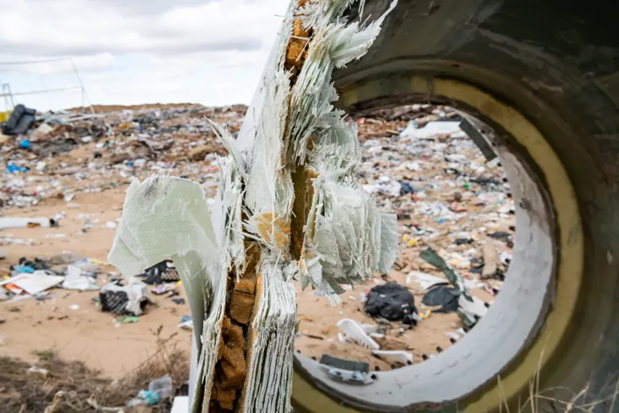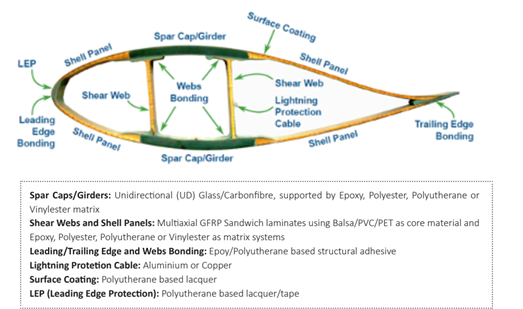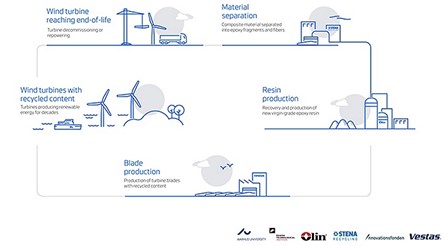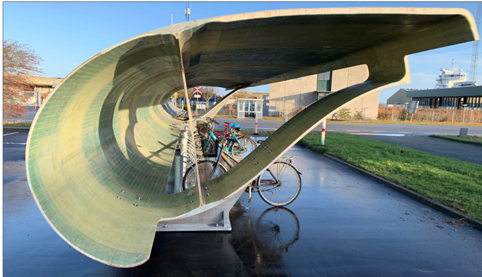Recycling Wind Turbine Blades: Path to Circularity

The fast expansion of the wind energy industry has resulted in a significant rise in Wind Turbine Blade (WTB) waste. Unfortunately, conventional disposal methods can exacerbate environmental issues.
As wind turbine blades reach the end of their lifecycle, newer, more efficient models replace them, leading to most of the old blades ending up in landfills. This creates significant disposal and image challenges for the clean-energy sector.
You can also read: Chemical Recycling of Carbon Fiber in Wind Turbine Blades
Managing Wind Turbine Blade Waste
Disposing of wind turbine blades through incineration or landfilling generates microplastics that persist in the environment and harm ecosystems. Additionally, these processes release pollutants that degrade air quality and pose health risks to humans. At the same time, the leachate from decomposing blades pollutes both groundwater and surface water, posing significant risks to aquatic ecosystems.
Recycling wind turbine blades is challenging due to the composite materials used in their construction. Wind turbine blades primarily comprise glass—or carbon-fiber-reinforced polymers (GFRP or CFRP), combining high-tensile-strength fibers with polymer resins. About 80% to 90% of a blade’s mass is a composite material, with reinforcing fibers up to 60% to 70% and resin 30% to 40%.
These materials are strong, lightweight, and durable, but their strength and durability make them difficult to recycle. The primary challenge lies in separating these elements into homogeneous input streams for new uses.

Generic cross-section of rotor blade. Courtesy of Accelerating Wind Turbine Blade Circularity – 2020.
Some recycling processes do not attempt to separate composite materials, while others may struggle to reproduce the structural characteristics of virgin materials. Blades typically use thermoset resins that form strong cross-linked polymers during curing, making it difficult to break them down to recover raw materials for new composite products.
Exploring Wind Turbine Blade Recycling Techniques
The growing demand for sustainable energy solutions increases the need for effective recycling methods for WTBs. Experts have proposed various wind-blade recycling techniques, including mechanical, thermal, and chemical processes:
- Microwave Pyrolysis: Microwave pyrolysis emerges as the most promising technique, capable of handling massive quantities of wind turbine blades (WTBs). Despite challenges and uncertainties, it shows potential for industrial-scale recycling.
- Mechanical Recycling: Widely used and energy-efficient, mechanical recycling involves shredding and reprocessing WTBs. This method is particularly viable for smaller blades.
- Fluidized Bed Recycling: This process demonstrates lower primary energy demand, reduced global warming potential, and lower power consumption, making it an environmentally friendly choice.
- Cement co-processing involves using shredded blades as an alternative fuel and raw material in cement kilns. This process reduces CO2 emissions from cement production and incorporates blade materials into the cement matrix.
Successful Case Studies in Sustainable Waste Management and Disposal
Vestas’ Circularity Solution
Vestas introduced an innovative solution to eliminate landfill disposal of epoxy-based turbine blades. By leveraging new chemical technology, Vestas can make these blades circular without redesigning them. This process, developed with Aarhus University and the Danish Technological Institute, breaks down epoxy resin into reusable materials. Once scaled, this technology will enable the reuse of legacy blade material, fostering a circular economy in the wind industry.

Vestas introduces a circularity solution to eliminate landfill disposal for turbine blades. Courtesy of Vestas.
Maximizing Wind Turbine Blade Lifecycle through Reuse and Repurposing
Reusing and repurposing wind turbine blades is crucial for extending their lifecycle and minimizing waste. It is essential to utilize and maintain blades for as long as possible, with regular servicing and repairs necessary to achieve their intended lifespan. For lifetime extension, a thorough assessment involving fatigue load analysis using SCADA data, site inspections, and maintenance reviews is necessary, potentially leading to repairs and reinforcements. Standards for lifetime extension have been developed by DNV-GL (DNVGL-ST-0262) and are being developed by the IEC (IEC TS 61400-28).

Blade repurposing: Bike shed in Aalborg, Denmark. Courtesy of Accelerating Wind Turbine Blade Circularity – 2020.
Companies in Europe and North America are also focusing on selling refurbished turbines and components. Beyond reuse, repurposing involves using parts of the blade for different applications, usually of lower value, such as playgrounds, street furniture, and structural components for buildings. However, these repurposing efforts are currently demonstration projects and not yet scalable solutions for the anticipated future volumes of blade waste.
